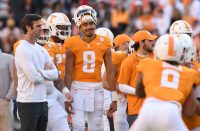New Year’s Day is one of my favorite holidays; I joke this time of year that many are spiritual in December’s holy days, but everyone is religious on January 1. It’s newness and grace on a calendar page. And there’s football!
January Matters.
In Tennessee’s upswing from 1989-2007, the Vols played in a traditional January bowl 15 times in 19 years. Tennessee stayed home in 2005, and caught back-to-back Peach Bowls in 2002 and 2003 (the latter was played on January 2, the only Peach/Chick-fil-A Bowl played in January between 1999 and its promotion to the College Football Playoff in 2014). And in December 1994, a freshman named Peyton Manning led the Vols to a 45-23 win over Virginia Tech in the Gator Bowl, which was played in The Swamp during construction on the Jacksonville Jaguars’ new stadium. That was the last of a four-year December run for the Gator Bowl, which returned to January the following season.
We rightfully hold up 1995-98 as Tennessee’s absolute peak: a 45-5 record in those four years was the best in college football, along with two SEC titles, a #2 finish in 1995, and a national championship. Extend it out to the “decade” of dominance from 1989-2001, when the Vols went 129-29-2 in 13 years, and that .813 winning percentage is the best in the SEC in that time (data via stassen.com). But Tennessee also had the best winning percentage in the SEC if you take it all the way to 1989-2007, decimal points ahead of the Gators (.7678) at 181-54-2 (.7679) in that 19-year run.
That math works out to around 10 wins a year in a 13-game season, 10.5 wins if you use the .813 percentage from 1989-2001. It was both expectation and celebration, and it almost always ended in January. We grew accustomed to starting the new year with football. And that, like many other things, has changed since 2008.
Let the (recent!) past die.
After appearing in traditional January 1 bowls 15 times in 19 years from 1989-2007, the Vols have been twice in the last dozen years. Tomorrow will make three.
Playing in any bowl game has become a 50/50 proposition: this season’s Gator Bowl is just the sixth time in these last twelve years Tennessee made the postseason at all. The Vols found their way to January following the 2014 (Gator) and 2015 (Outback) seasons, plus a pair of Music City Bowls and the December Chick-fil-A Bowl in Lane Kiffin’s 2009 season.
As is the case when you’re building a program, what you celebrate early shouldn’t be what you celebrate often. This year – especially this year, given how things looked in September – Tennessee making it to the Gator Bowl is a job well done. As we’ve been saying since May, if the Vols win, an 8-5 finish would be the third-best record of these last dozen years, bested only by a pair of 9-4’s from Butch Jones in 2015-16 that left so much more on the table.
The math is noteworthy for the 2019 team at the close of the decade as well: assigning the Gator Bowl outcome to the last decade will break a 62-62 tie for the Vols since 2010.
After having the SEC’s best winning percentage from 1989-2007, the Vols are 11th in the league from 2008-2019, besting only Arkansas, Kentucky, and Vanderbilt. The 2010’s stick out like a sore thumb in Tennessee’s own past:
| Decade | W | L | Pct |
| 2010s | 62 | 62 | 0.500 |
| 2000s | 83 | 44 | 0.654 |
| 1990s | 99 | 22 | 0.818 |
| 1980s | 77 | 37 | 0.675 |
| 1970s | 75 | 39 | 0.658 |
| 1960s | 67 | 32 | 0.677 |
| 1950s | 72 | 31 | 0.699 |
Tennessee historically wins between 65-70% of its games, averaging around 8.75 wins per year in a 13-game season. Should the Vols return to their own historical precedent, an 8-5 season would be rightfully considered below average.
All of this is why it’s really interesting to me that this game comes at the landmark of a new decade. You can’t redeem a decade-plus of frustration by beating Indiana to get one game over .500 the last 10 years. But a win could be the last, best example of what has a chance to be the greatest legacy of the 2019 Vols.
And if you don’t love me now
When the Vols lost to Georgia State and BYU, we wrote that progress – the only thing that mattered this season – should be measured not to the top, but from the bottom. Remarkably, this team still found a way to put the third-best year of the last dozen back on the table.
All these years and all these words about getting “back” have usually been in reference to those peak years: the late 90’s, or even that “decade” of dominance. But Tennessee is still trying to get back to being Tennessee: a program that can call a nine-win season average, allowing us to realistically hope for something more every fall and play football most Januaries.
This team, at the end of this decade, fought their way from its lowest point. And if Jeremy Pruitt and the Vols return to Tennessee’s historical success in the next decade, this group can forever be remembered as a bridge between the two, and one of the most important links in the Volunteer chain.
It’s true for those who will play their final game in a Tennessee uniform against Indiana: Jennings and Callaway, Bituli and Taylor, Nigel Warrior and probably Trey Smith. And it’s true for those who have a chance to shine tomorrow and even brighter in 2020: Jarrett Guarantano, a host of running backs, freshmen who aren’t freshmen anymore, and guys like Bryce Thompson who are one game away from being the upperclassmen leaders.
We’ve seen a lot of new and unusual in these last ten years, perhaps nothing on the field more so than these last twelve games. Against the odds, this team won their way to a thirteenth opportunity in January. They are, like all who wear orange, tied to Tennessee’s past. And they are laying the foundation for a better future, with one opportunity left.
It’s a new year, and Tennessee is playing football in January. So far, so good.
Go Vols.





Nicely “penned”… lets forget the last decade and move on. Start the New Year right… Go Vols!